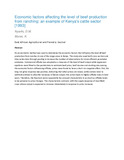| dc.contributor.author | Nyariki, Dickson M. | |
| dc.contributor.author | Munei, K. | |
| dc.date.accessioned | 2017-02-25T07:12:40Z | |
| dc.date.available | 2017-02-25T07:12:40Z | |
| dc.date.issued | 1993 | |
| dc.identifier.uri | http://hdl.handle.net/123456789/196 | |
| dc.identifier.uri | http://www.tandfonline.com/doi/abs/10.1080/00128325.1993.11663192 | |
| dc.identifier.uri | http://erepository.uonbi.ac.ke/handle/11295/18652 | |
| dc.identifier.uri | http://agris.fao.org/agris-search/search.do?recordID=KE9642514 | |
| dc.description.abstract | An econometric method was used to determine the economic factors that influence the level of beef production from ranches in one of the range areas in Kenya. The study also used both cross section and time-series data through pooling to increase the number of observations for more efficient parameter estimates. Commercial offtake was adopted as a measure of the level of beef output while regression equitions were fitted to the pooled data to estimate beef price, beef income and stocking rate among the economic factors influencing offtake, prices were found to have a short-run negative effect. But, the long-run price response was positive, indicating that when prices are raised, cattle owners tend to withhold animals to allow for increases in future output; this action leads to higher offtake rates in later years. Therefore, the livestock sector apparently has unusual characteristic in as much as offtake tends to be perverse to price changes. This characteristic contrasts with the supply response of most field crops whose output is expected to increase immediately in response to price increases | en_US |
| dc.language.iso | en | en_US |
| dc.title | Economic factors affecting the level of beef production from ranching: an example of Kenya's cattle sector | en_US |
| dc.type | Article | en_US |

